Baseball statistics play an important role in evaluating the progress of a player or team.
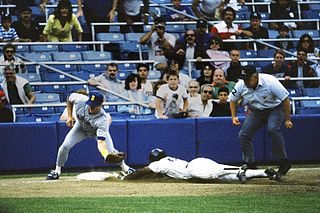
In baseball, a stolen base occurs when a runner advances to a base unaided by other actions and the official scorer rules that the advance should be credited to the action of the runner. The umpires determine whether the runner is safe or out at the next base, but the official scorer rules on the question of credit or blame for the advance under Rule 10 of the MLB's Official Rules.

Softball is a game similar to baseball played with a larger ball on a smaller field, with only underhand pitches permitted. Softball is played competitively at club levels, the college level, and the professional level. The game was first created in 1887 in Chicago by George Hancock.

In baseball or softball, a strikeout occurs when a batter accumulates three strikes during a time at bat. It usually means that the batter is out. A strikeout is a statistic recorded for both pitchers and batters, and is denoted by K in scorekeeping and statistics. A "strikeout looking"—in which the batter does not swing and the third strike is called by the umpire—is usually denoted by a ꓘ.
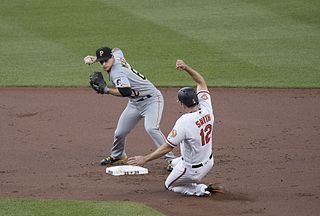
In baseball and softball, a double play is the act of making two outs during the same continuous play. Double plays can occur any time there is at least one baserunner and fewer than two outs.
In baseball, a triple play is the act of making three outs during the same play. There have only been 735 triple plays in Major League Baseball (MLB) since 1876, an average of just over five per season.
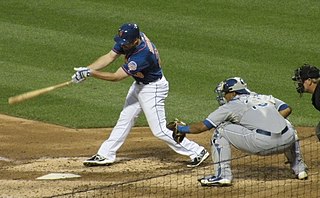
Catcher is a position in baseball and softball. When a batter takes their turn to hit, the catcher crouches behind home plate, in front of the (home) umpire, and receives the ball from the pitcher. In addition to this primary duty, the catcher is also called upon to master many other skills in order to field the position well. The role of the catcher is similar to that of the wicket-keeper in cricket.

In baseball, the pitch is the act of throwing the baseball toward home plate to start a play. The term comes from the Knickerbocker Rules. Originally, the ball had to be thrown underhand, much like "pitching in horseshoes". Overhand pitching was not allowed in baseball until 1884.

A first baseman, abbreviated 1B, is the player on a baseball or softball team who fields the area nearest first base, the first of four bases a baserunner must touch in succession to score a run. The first baseman is responsible for the majority of plays made at that base. In the numbering system used to record defensive plays, the first baseman is assigned the number 3.
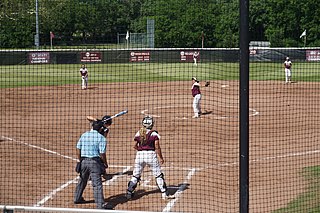
In baseball or softball, a pitchout is a ball that is intentionally thrown high and outside the strike zone with the purpose of preventing a stolen base, thwarting a hit and run, or to prevent a run-scoring play on a suicide squeeze play. The pitcher delivers the ball in such a manner for it to be unhittable and in a position where the catcher can quickly leap to their feet to catch it. A well-thrown pitchout will allow the catcher to receive the ball standing up as opposed to their usual squat, giving them a better line to throw to a base without the pitcher or the batter obstructing their vision or aim. Moreover, it is easier to throw a ball with more force from a standing position than it is from a squat, which is why most catchers leap to their feet when attempting to throw out a base stealer. A pitchout is a type of intentional ball, but differs in that a pitchout is thrown harder to give the catcher the most time to throw out the base runner.
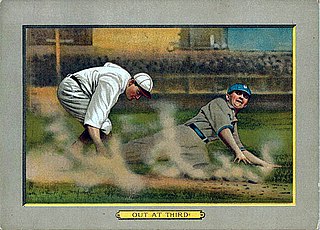
In baseball, an out occurs when the umpire rules a batter or baserunner out. When a batter or runner is out, they lose their ability to score a run and must return to the dugout until their next turn at bat. When three outs are recorded in a half-inning, the batting team's turn expires.

Throughout the history of baseball, the rules have frequently changed as the game has continued to evolve. The rules of baseball can vary slightly from league to league, with there being dozens of leagues worldwide. A few common rules most professional leagues have in common is that four balls is a base on balls, three strikes is a strikeout, and three outs end a half-inning. One example of differing rules in professional leagues is the use of a pitch clock, which in Major League Baseball (MLB) is in place to speed up the pace of the game by forcing pitchers to pitch in a 15–20 second window, while in Nippon Professional Baseball (NPB) no such rule exists.
In baseball, interference occurs in situations in which a person illegally changes the course of play from what is expected. Interference might be committed by players on the offense, players not currently in the game, catchers, umpires, or spectators. Each type of interference is covered differently by the rules.

In baseball, a pitcher can commit illegal motions or actions that constitute a balk. Most of these violations involve pitchers pretending to pitch when they have no intention of doing so. In games played under the Official Baseball Rules that govern professional play in the United States and Canada, a balk results in a dead ball or delayed dead ball. In certain other circumstances, a balk may be wholly or partially disregarded. In the United States, under the National Federation of State High School Associations, a balk results in an immediate dead ball. In the event a balk is enforced, the pitch is generally nullified, each runner is awarded one base, and the batter (generally) remains at bat with the previous count. The balk rule in Major League Baseball was introduced in 1898.

Felix Anthony "Tippy" Martinez, is an American retired professional baseball left-handed pitcher. He pitched 14 seasons in Major League Baseball (MLB) between 1974 and 1988, primarily as a relief pitcher. The majority of his career (1976–1986) was spent as a member of the Baltimore Orioles, where he was a member of 1983 World Series championship team.
A hit and run is a high risk, high reward offensive strategy used in baseball. It uses a stolen base attempt to try to place the defending infielders out of position for an attempted base hit.

Baseball scorekeeping is the practice of recording the details of a baseball game as it unfolds. Professional baseball leagues hire official scorers to keep an official record of each game, but many fans keep score as well for their own enjoyment. Scorekeeping is usually done on a printed scorecard and, while official scorers must adhere precisely to one of the few different scorekeeping notations, most fans exercise some amount of creativity and adopt their own symbols and styles.
This is an alphabetical list of selected unofficial and specialized terms, phrases, and other jargon used in baseball, along with their definitions, including illustrative examples for many entries.
The wheel play is a defensive strategy in baseball designed to defend against a sacrifice bunt. The play's name derives from the wheel-like rotation of the infielders.
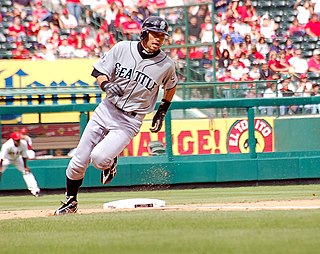
In baseball, base running is the act of running from base to base, performed by members of the team at bat.
















